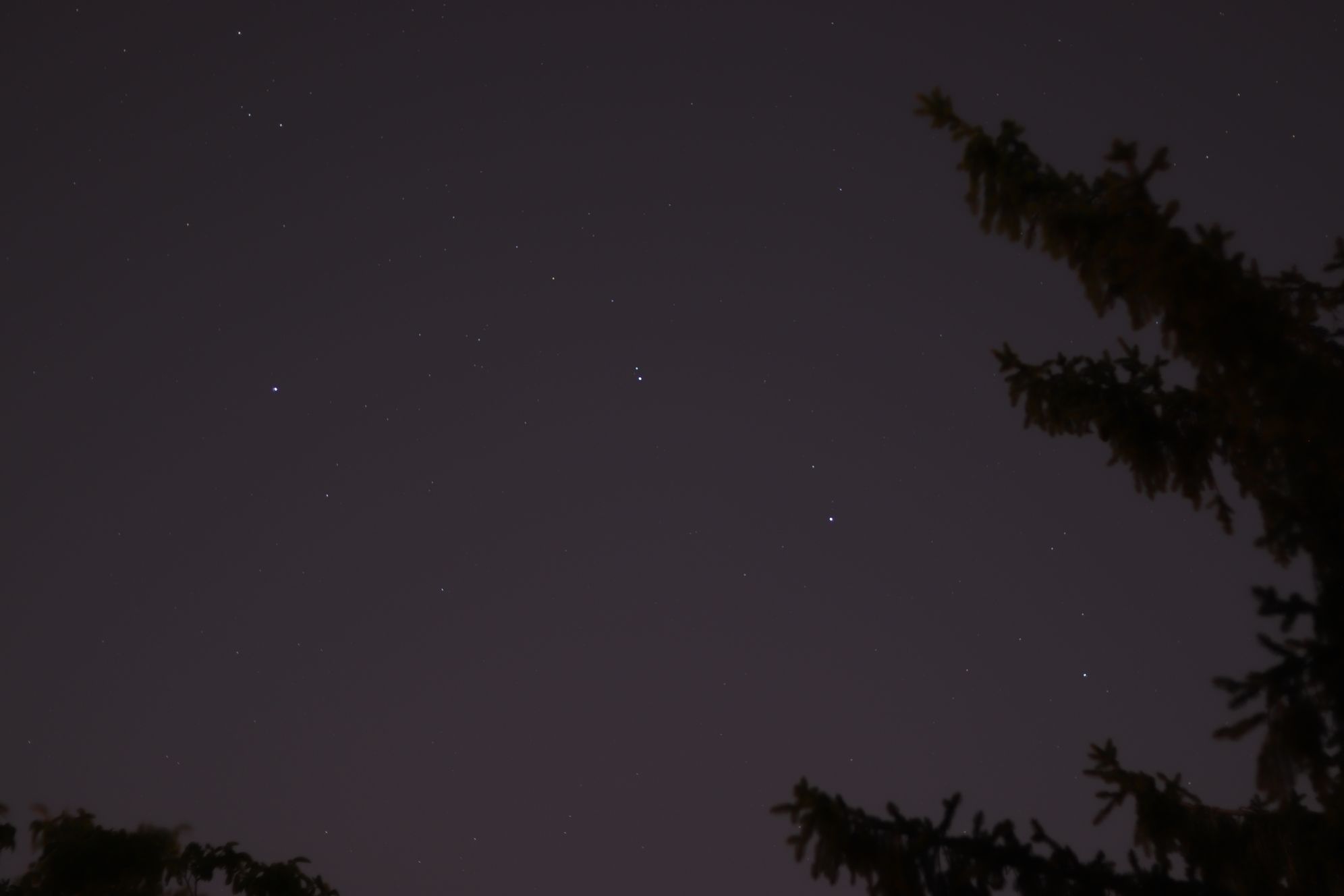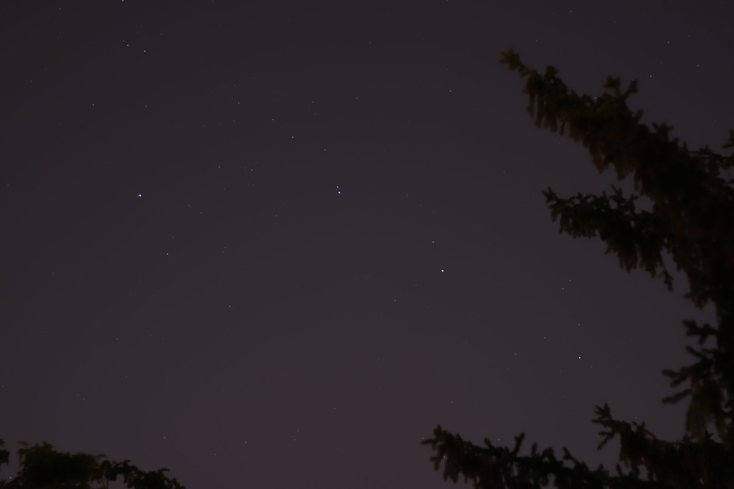
Stellar Pixar
During this summer, I could take my first serious photography of stars. In this article, I share this picture and what I learned with you ... Cet été, j'ai pu faire ma première vraie photographie d'étoiles. Dans cet article, je partage cette image et ce que j'ai appris avec vous ...

50mm ƒ/1.8 8s ISO-100
I also caught a plane ! 32 minutes elapsed between these two pictures, and we can see by how much our Earth rotated during this time : J'ai aussi capturé un avion ! 32 minutes se sont écoulées entre ces deux photos, et on peut voir comment notre Terre a tourné entre temps :

50mm ƒ/1.8 8s ISO-100
The following animation spans on 1 hour and a half (22:36-23:55), and helps to better visualize this rotation : L'animation suivante s'étale sur une heure et demie (22:36-23:55), et aide à mieux visualiser cette rotation :

The three stars that we are interested in are the three brightest ones starting from the left of the picture. Les trois étoiles qui vont nous intérésser ici sont les trois éclats les plus brillants en partant de la gauche de l'image.
Alkaid
The first brightest at the left is Alkaid. The Bayer designation of Alkaid is Eta Ursae Majoris. Eta, written η, is the seventh letter of the Greek alphabet, and Ursae Majoris designate the cluster of stars that looks like a Great Bear. So Eta Ursae Majoris is the seventh star of the Great Bear constellation. La première étoile la plus à gauche est Alkaid. Sa désignation de Bayer est Eta Ursae Majoris. Eta, qu'on écrit η, est la septième lettre de l'alphabet grecque, et Ursae Majoris désigne le groupe d'étoile qui ressemble à une grande ourse. Eta Ursae Majoris est donc la septième étoile de la constellation de la Grande Ourse.
The traditional name Alkaid comes from the Arabic word القايد meaning the leader of the daughters of the bier. The mourning maidens are the three stars of the Great Bear's tail, Alkaid, Mizar, and Alioth ; while the four other stars, Megrez, Phecda, Merak, and Dubhe, are the bier. Le nom traditionnel Alkaid vient du mot arabe القايد qui signifie la meneuse des filles en deuil. Les filles en deuil sont les trois étoiles de la queue de la Grande Ourse, Alkaid, Mizar et Alioth ; tandis que les quatre autres étoiles, Megrez, Phecda, Merak et Dubhe, sont le cercueil.
The Hindus knew this star as Marīci, one of the Seven Rishis. Les Hindous connaissaient cette étoile comme Marīci, l'un des sept Rishis.
In Japan and Korea, Alkaid is known as Hagunsei and Mukokseong, respectively the military breaking star or most corner star. Both meanings come from ancient China's influence in both countries. Au Japon et en Corée, l'alkaid est connu sous les noms de Hagunsei et Mukokseong, respectivement l'étoile filante militaire et l'étoile la plus anguleuse. Les deux significations proviennent de l'influence historique de la Chine dans les deux pays.
Mizar
The second brightest star from the left is Mizar. The Bayer designation of Mizar is Zeta Ursae Majoris, for the sixth star of the Great Bear constellation.
If you look closely, you will see an other point of light close to Mizar. This is Alcor.
The traditional name Mizar comes from the Arabic word المئزر (Mi'zar) meaning cover. The Arabs called Mizar and Alcor the horse and the rider, and being able to distinguish the two stars was used as test of eyesight.
In traditional Indian astronomy, Mizar is known as Vashistha, one of the seven sages (Saptarshi), and Alcor is known as his wife Arundhati.
Chinese Taoism personifies Mizar as the Lu star, associated to prosperity.
Alioth
The third brightest star from the left is Alioth. The Bayer designation of Alioth is Epsilon Ursae Majoris, for the fifth star of the Great Bear constellation.
The traditional name Alioth comes from the Arabic word ألية الحمل (Alyat Al-Hamal) meaning the fatty tail of the lamb. This star was known to the Hindus as Añgiras, one of the seven sages (Saptarshi).
The light emitted by Alioth takes 82 years to reach Earth.
Ursa Major

These three stars belong to the Ursa Major constellation, meaning Great Bear. They also belong to a subpart of Ursa Major, commonly called the Big Dipper, or the Plough.
In European star charts, the constellation was visualized with the square of the Big Dipper forming the bear's body and the chain of stars forming the Dipper's handle as a long tail. However, bears do not have long tails, and Jewish astronomers considered Alioth, Mizar, and Alkaid instead to be three cubs following their mother, while the Native Americans saw them as three hunters.
The Iroquois interpreted Alioth, Mizar, and Alkaid as three hunters pursuing the Great Bear. According to one version of their myth, the first hunter (Alioth) is carrying a bow and arrow to strike down the bear. The second hunter (Mizar) carries a large pot (Alcor) on his shoulder in which to cook the bear while the third hunter (Alkaid) hauls a pile of firewood to light a fire beneath the pot.
The Wasco-Wishram Native Americans interpreted the constellation as 5 wolves and 2 bears that were left in the sky by the mythological character Coyote.
It's funny how the constellation of Ursa Major has been seen as a bear by several distinct civilizations. This may stems from a common oral tradition of Cosmic Hunt myths stretching back more than 13,000 years.
In East Asian traditions, the Big Dipper is called 北斗 (Chinese: běidǒu, Japanese: hokuto) meaning North Dipper, and in ancient times, each one of the seven stars had a specific name, often coming themselves from ancient China :
| Common name | Bayer designation | East Asian designation | Meaning |
|---|---|---|---|
| Dubhe | Alpha Ursae Majoris | 樞 (Chi: shū, Jap: sū) | Pivot |
| Merak | Beta Ursae Majoris | 璇 (Chi: xuán, Jap: sen) | Beautiful jade |
| Phecda | Gamma Ursae Majoris | 璣 (Chi: jī, Jap: ki) | Pearl |
| Megrez | Delta Ursae Majoris | 權 (Chi: quán, Jap: ken) | Balance |
| Alioth | Epsilon Ursae Majoris | 玉衡 (Chi: yùhéng, Jap: gyokkō) | Measuring rod of jade |
| Mizar | Zeta Ursae Majoris | 開陽 (Chi: kāiyáng, Jap: kaiyō) | Opening of the Yang |
| Alkaid | Eta Ursae Majoris | 劍先 (Chi: jiàn xiān, Jap: ken saki) | End of the sword |
In Shinto, the seven largest stars of Ursa Major belong to Amenominakanushi, the oldest and most powerful of all Kami.
Sources
- My boy Wikipedia
- The SkyView Free app to identify the stars
- https://www.youtube.com/watch?v=79EIOHzetXY for an explanation of Alcor and Mizar